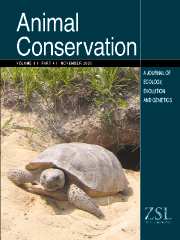Article contents
Umbrella species: critique and lessons from East Africa
Published online by Cambridge University Press: 30 April 2003
Abstract
Umbrella species are ‘species with large area requirements, which if given sufficient protected habitat area, will bring many other species under protection’. Historically, umbrella species were employed to delineate specific reserve boundaries but are now used in two senses: (1) as aids to identifying areas of species richness at a large geographic scale; (2) as a means of encompassing populations of co-occuring species at a local scale. In the second sense, there is a dilemma as to whether to maximize the number or viability of background populations; the umbrella population itself needs to be viable as well. Determining population viability is sufficiently onerous that it could damage the use of umbrella species as a conservation shortcut. The effectiveness of using the umbrella-species concept at a local scale was investigated in the real world by examining reserves in East Africa that were gazetted some 50 years ago using large mammals as umbrella species. Populations of these species are still numerous in most protected areas although a few have declined. Populations of other, background species have in general been well protected inside reserves; for those populations that have declined, the causes are unlikely to have been averted if reserves had been set up using other conservation tools. Outside one reserve, Katavi National Park in Tanzania, background populations of edible ungulates and small carnivores are lower than inside the reserve but small rodent and insectivore abundance is higher. While we cannot compare East African reserves to others not gazetted using umbrella species, the historical record in this region suggests that umbrella species have been an effective conservation shortcut perhaps because most reserves were initially large and could encompass substantial populations of background species. It is therefore premature to discard the local-scale umbrella-species concept despite its conceptual difficulties.
- Type
- Research Article
- Information
- Copyright
- © 2003 The Zoological Society of London
- 122
- Cited by


